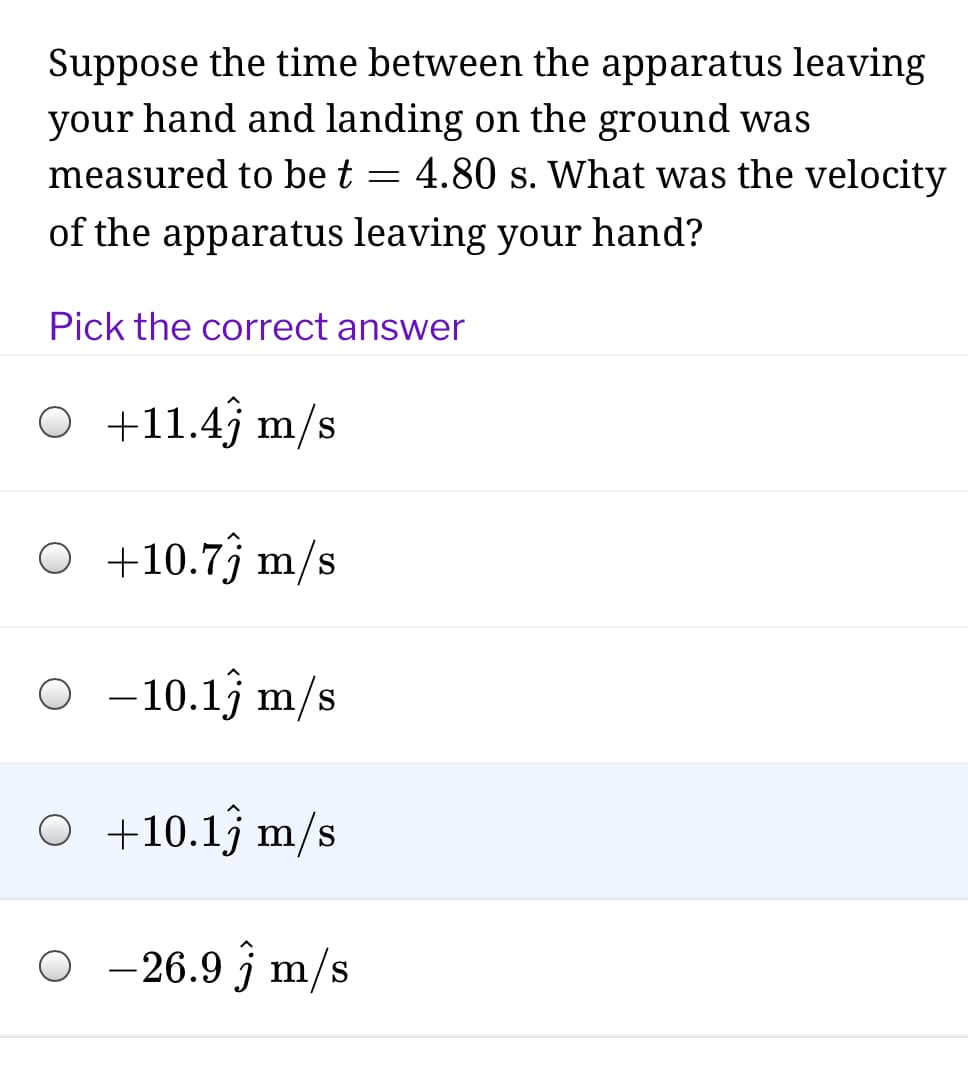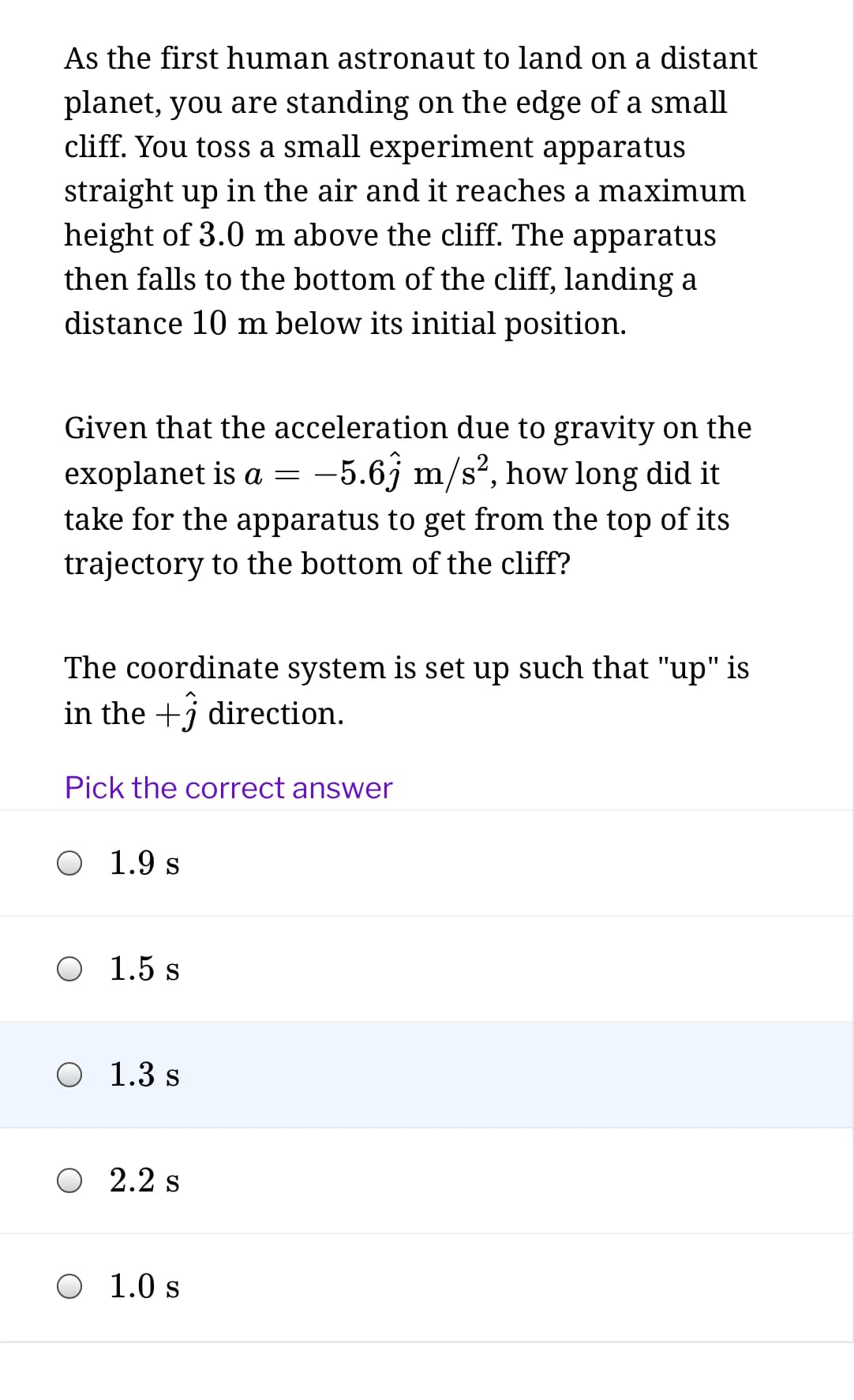Problem: As the first human astronaut to land on a distant planet, you are standing on the edge of a small cliff. You toss a small experiment apparatus straight up in the air and it reaches a maximum height of 3.0m above the cliff. The apparatus then falls to the bottom of the cliff, landing a distance 10 m below its initial position. A) Given that the acceleration due to gravity on the exoplanet is a=−5.6j^ m/s^2 {REFER TO ONE OF THE PICTURE}, how long did it take for the apparatus to get from the top of its trajectory to the bottom of the cliff? The coordinate system is set up such that "up" is in the +j^ direction. Answer a): 2.2 seconds. ****B)Suppose the time between the apparatus leaving your hand and landing on the ground was measured to be t=4.80s. What was the velocity of the apparatus leaving your hand?
Problem: As the first human astronaut to land on a distant planet, you are standing on the edge of a small cliff. You toss a small experiment apparatus straight up in the air and it reaches a maximum height of 3.0m above the cliff. The apparatus then falls to the bottom of the cliff, landing a distance 10 m below its initial position. A) Given that the acceleration due to gravity on the exoplanet is a=−5.6j^ m/s^2 {REFER TO ONE OF THE PICTURE}, how long did it take for the apparatus to get from the top of its trajectory to the bottom of the cliff? The coordinate system is set up such that "up" is in the +j^ direction. Answer a): 2.2 seconds. ****B)Suppose the time between the apparatus leaving your hand and landing on the ground was measured to be t=4.80s. What was the velocity of the apparatus leaving your hand?
College Physics
10th Edition
ISBN:9781285737027
Author:Raymond A. Serway, Chris Vuille
Publisher:Raymond A. Serway, Chris Vuille
Chapter2: Motion In One Dimension
Section: Chapter Questions
Problem 68AP: The driver of a truck slams on the brakes when he sees a tree blocking the road. The truck slows...
Related questions
Concept explainers
Topic Video
Question
PLEASE WORK ON THE SECOND QUESTION(Question B).
Problem:
As the first human astronaut to land on a distant planet, you are standing on the edge of a small cliff. You toss a small experiment apparatus straight up in the air and it reaches a maximum height of 3.0m above the cliff. The apparatus then falls to the bottom of the cliff, landing a distance 10 m below its initial position.
A) Given that the acceleration due to gravity on the exoplanet is a=−5.6j^ m/s^2 {REFER TO ONE OF THE PICTURE}, how long did it take for the apparatus to get from the top of its trajectory to the bottom of the cliff?
The coordinate system is set up such that "up" is in the +j^ direction.
Answer a): 2.2 seconds.
****B)Suppose the time between the apparatus leaving your hand and landing on the ground was measured to be t=4.80s. What was the velocity of the apparatus leaving your hand?

Transcribed Image Text:Suppose the time between the apparatus leaving
your hand and landing on the ground was
measured to be t = 4.80 s. What was the velocity
of the apparatus leaving your hand?
Pick the correct answer
O +11.4j m/s
O +10.7j m/s
O - 10.13 m/s
O +10.13 m/s
-26.9 j m/s

Transcribed Image Text:As the first human astronaut to land on a distant
planet, you are standing on the edge of a small
cliff. You toss a small experiment apparatus
straight up in the air and it reaches a maximum
height of 3.0 m above the cliff. The apparatus
then falls to the bottom of the cliff, landing a
distance 10 m below its initial position.
Given that the acceleration due to gravity on the
exoplanet is a =
-5.6j m/s?, how long did it
take for the apparatus to get from the top of its
trajectory to the bottom of the cliff?
The coordinate system is set up such that "up" is
in the +j direction.
Pick the correct answer
1.9 s
O 1.5 s
1.3 s
O 2.2 s
O 1.0 s
Expert Solution
This question has been solved!
Explore an expertly crafted, step-by-step solution for a thorough understanding of key concepts.
This is a popular solution!
Trending now
This is a popular solution!
Step by step
Solved in 3 steps

Knowledge Booster
Learn more about
Need a deep-dive on the concept behind this application? Look no further. Learn more about this topic, physics and related others by exploring similar questions and additional content below.Recommended textbooks for you

College Physics
Physics
ISBN:
9781285737027
Author:
Raymond A. Serway, Chris Vuille
Publisher:
Cengage Learning

Glencoe Physics: Principles and Problems, Student…
Physics
ISBN:
9780078807213
Author:
Paul W. Zitzewitz
Publisher:
Glencoe/McGraw-Hill

Principles of Physics: A Calculus-Based Text
Physics
ISBN:
9781133104261
Author:
Raymond A. Serway, John W. Jewett
Publisher:
Cengage Learning

College Physics
Physics
ISBN:
9781285737027
Author:
Raymond A. Serway, Chris Vuille
Publisher:
Cengage Learning

Glencoe Physics: Principles and Problems, Student…
Physics
ISBN:
9780078807213
Author:
Paul W. Zitzewitz
Publisher:
Glencoe/McGraw-Hill

Principles of Physics: A Calculus-Based Text
Physics
ISBN:
9781133104261
Author:
Raymond A. Serway, John W. Jewett
Publisher:
Cengage Learning